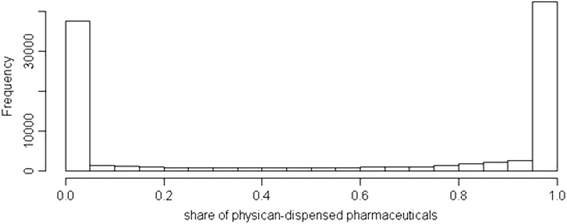Physician drug dispensing in Switzerland: association on health care expenditures and utilization
- PMID: 27391118
- PMCID: PMC4938921
- DOI: 10.1186/s12913-016-1470-y
Physician drug dispensing in Switzerland: association on health care expenditures and utilization
Abstract
Background: Several countries recently reassessed the roles of drug prescribing and dispensing, either by enlarging pharmacists' rights to prescribe (e.g. the US and the United Kingdom) or by limiting physicians' rights to dispense (e.g. Taiwan and South Korea). While integrating the two roles might increase supply and be convenient for patients, concern is that drug mark-ups incite providers to prescribe unnecessary drugs. We aimed to assess the association of physician dispensing (PD) in Switzerland on various outcomes.
Methods: We performed a retrospective cohort study, using health care claims data for patients in the year 2013. The analysis of the association of PD was perfomed using a large patient level dataset and several target variables, including the number of different chemical agents, share of generic drugs, number of visits to physicians and expenditures. Different multivariate econometric models were applied in order to capture the association PD on the target variables.
Results: A total of 101'784 patients were enrolled in 2013, whereas 54 % were PD patients. We find that PD is associated with lower pharmaceutical expenditure per patient, which can be explained by an increased use of generic drugs. The decrease is compensated by higher use of physician services. We find no significant impact of physician dispensing on total health care expenditure.
Conclusions: Our study offers insights for policy makers who are (re-)considering the separation between drug prescribing and dispensing, either by allowing physicians to dispense or pharmacists to prescribe certain drugs. In terms of total health care expenditures, we find no difference between the two systems, so we are doubtful that changing dispensing rights are a good measure to contain cost, at least in Switzerland.
Keywords: Health care expenditures; Physician dispensing; Prescription drugs.
Figures
References
-
- Latter S, Blenkinsopp A, Smith A, Chapman S, Tinelli M, Gerard K, et al. Evaluation of nurse and pharmacist independent prescribing. Department of health policy research project 016 0108; 2010. Available at http://eprints.soton.ac.uk/184777/3/ENPIPfullreport.pdf?bcsi_scan_e4e14c....
-
- Arrow K. Uncertainty and the Welfare Economics of Medical Care. Am Econ Rev. 1963;53:941–73.
-
- Eggleston K. Prescribing institutions: explaining the evolution of physician dispensing. J Inst Econ. 2012;8:247–70.
MeSH terms
Substances
LinkOut - more resources
Full Text Sources
Other Literature Sources


